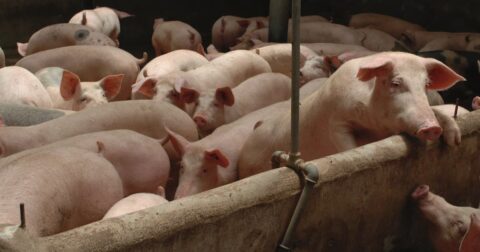News
Our Favorites Stories of 2025
Food•5 min read
Reported
By rescuing animals from captivity and documenting slaughterhouse facilities, activists aim to disrupt oppressive institutions—like factory farms—that harm both human and nonhuman animals and the planet.


Words by Elizabeth Wanaselja
Alexandra Paul, a health coach and former Baywatch actor, is one of seven Direct Action Everywhere (DxE) activists arrested in September of this year for attempting to rescue a pig—whom they named Greta—from the largest West Coast slaughterhouse in the United States. The Farmer John’s slaughterhouse, located in Vernon, California, where the rescue attempt occurred, is owned by Smithfield Foods, the world’s largest pork producer. Dressed in workers’ garb and hard hats, the activists managed to carry Greta out of her holding pen before being physically barricaded by the facility’s employees. The activists were later charged with trespassing.
DxE, whose mission is to “change the world for animals in one human generation”, utilizes “direct action”—peaceful protests, marches, vigils, open rescues—to change the systems that abuse and exploit animals. By rescuing animals from captivity and documenting slaughterhouse facilities, the organization aims to disrupt oppressive institutions—like factory farms—that harm both human and nonhuman animals and the planet. Although Greta ultimately could not be saved, the activists successfully retrieved a hidden camera from inside the facility, providing the public with its first glimpse into this particular slaughterhouse’s operations and abuses.
I recently spoke with Paul regarding the recent rescue attempt. The following is a lightly edited excerpt of our conversation.
Elizabeth Wanaselja: Why target Smithfield Foods? Why this Farmer John’s slaughterhouse in particular?
Alexandra Paul: [Smithfield Foods] might be the largest pig killer in the world and they are expanding. That specific facility in Vernon, California, processes between 7,000 and 9,000 pigs a day. “Process” would be their word—they murder, they gas, and they stab pigs. On the walls around that facility, someone painted murals of happy pigs, happy farmers, and bucolic fields. It’s just one big lie. It’s a place where pigs die.
EW: What did you notice about the conditions inside the facility?
AP: I saw hundreds of pigs in paddocks [who have] never been free—have always been in a small enclosure. They are six months old, haven’t been fed or given any water, and they are going to be gassed within hours. These pigs have traveled maybe 13 hours from Utah in a hot truck and they’re dumped into paddocks. They’re put in the gas chamber which is completely dark—in small groups, maybe 10—and they’re gassed, but not killed. Then they are strung up and they’re stabbed. [The slaughterhouse] wants them alive so that the heart [pumping] will help to bleed them out. [Then] if they’re not [already] dead, they’re supposed to be stunned and killed with a bolt gun, but who knows if they are, considering how fast those [processing] lines go.
EW: How does rescuing a single pig help to further the animal rights movement?
AP: Any message of hope is important. When [DxE] documents a rescue and the animal in his or her new home, it shows people that this [animal] is an individual and people will be able to relate to that individual and understand that he or she has feelings, needs, and desires just like us.
EW: Although the rescue itself was unsuccessful, do you consider the attempt to be a success?
AP: Any attempt is a win. [Where I was being] held I was able to see Greta because they didn’t put her back into the paddock right away with the other pigs. She was in the aisles, trotting up and down, and I realized as I was standing there that she probably had never had that much space. [She had] no idea what she could have had if the workers hadn’t locked us in. I got very sad at that moment. The workers [probably] thought it was because I was being arrested, but it was from watching her saunter up and down the aisles. By the time we were released, she was probably dead, probably gassed.
EW: Have you watched any of the footage from the slaughterhouse’s camera that was retrieved that night? If so, what shocked you about it?
AP: I’m not shocked because I know what happens there—I’m just amazed people can do [that kind of work]. It must be such a hard job. DxE makes sure to clarify that this is not about [blaming] the workers inside the slaughterhouse, only the systems and corporations [behind] it.
EW: How has direct action been successful in swaying public opinion and advancing legislation?
AP: Direct action helps sway public opinion, which, by extension, helps change legislation. We’re not masked so we look like normal people whom somebody can relate to. [Direct action] makes the animal rights movement more mainstream, and it helps [people] relate their love for their cat, dog, or horse to that individual on the farm, for example, or even to a rat or a mouse.
EW: If you knew ahead of time that you were going to be arrested and you would be unable to save Greta, would you still have made the attempt?
AP: Yes, definitely. Every act against a corporation that abuses animals is important, even if it doesn’t change that company right then. Most of what activists do doesn’t have an effect right away—it’s accumulated over years of consistent action. It’s really important that we continue to try and bring these cases to court. [Factory farming] is going to change—it’s just whether people want to be part of the change or be part of the suffering of billions of animals until things change—whether they want to be ahead of the curve or they want to be dragged along.